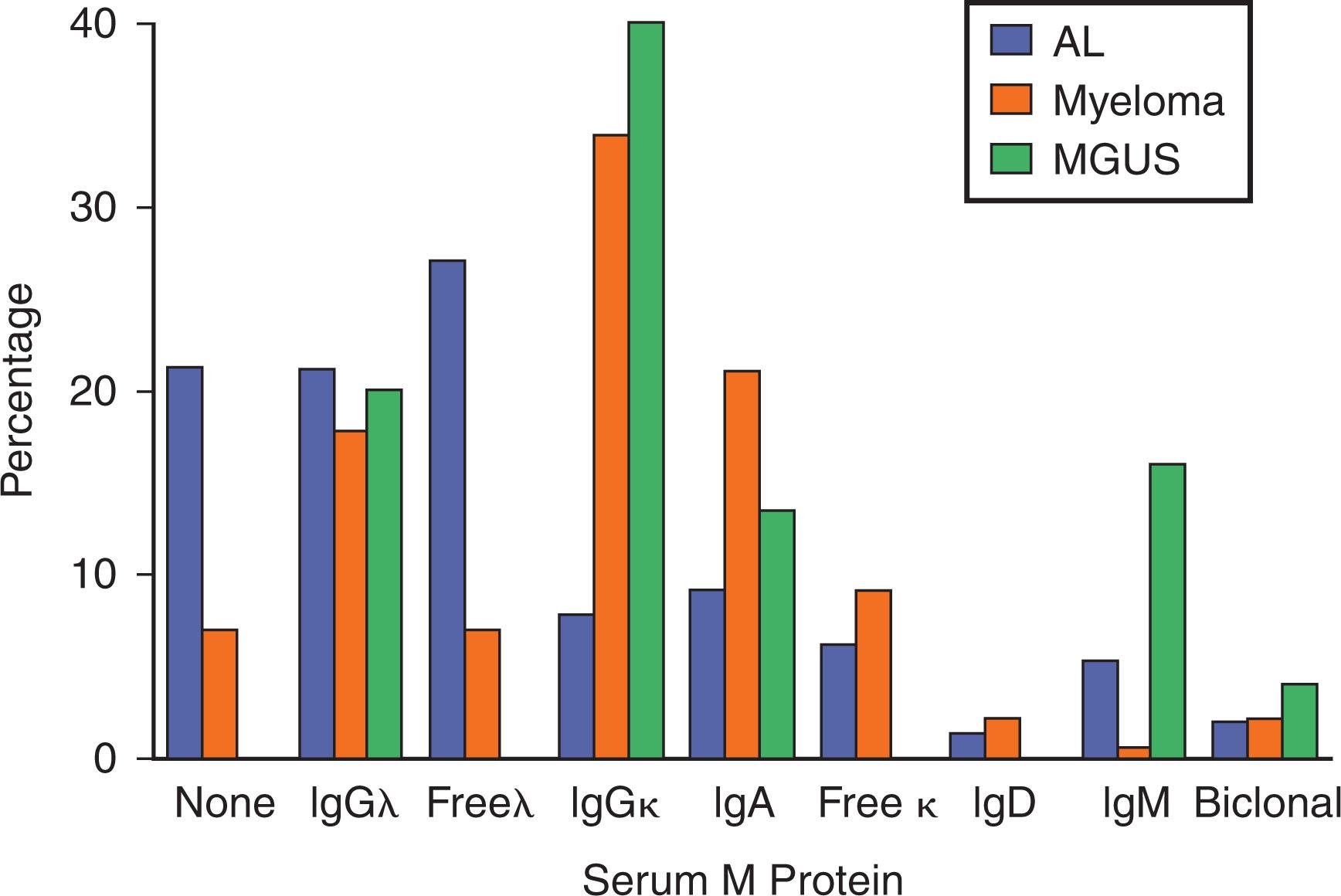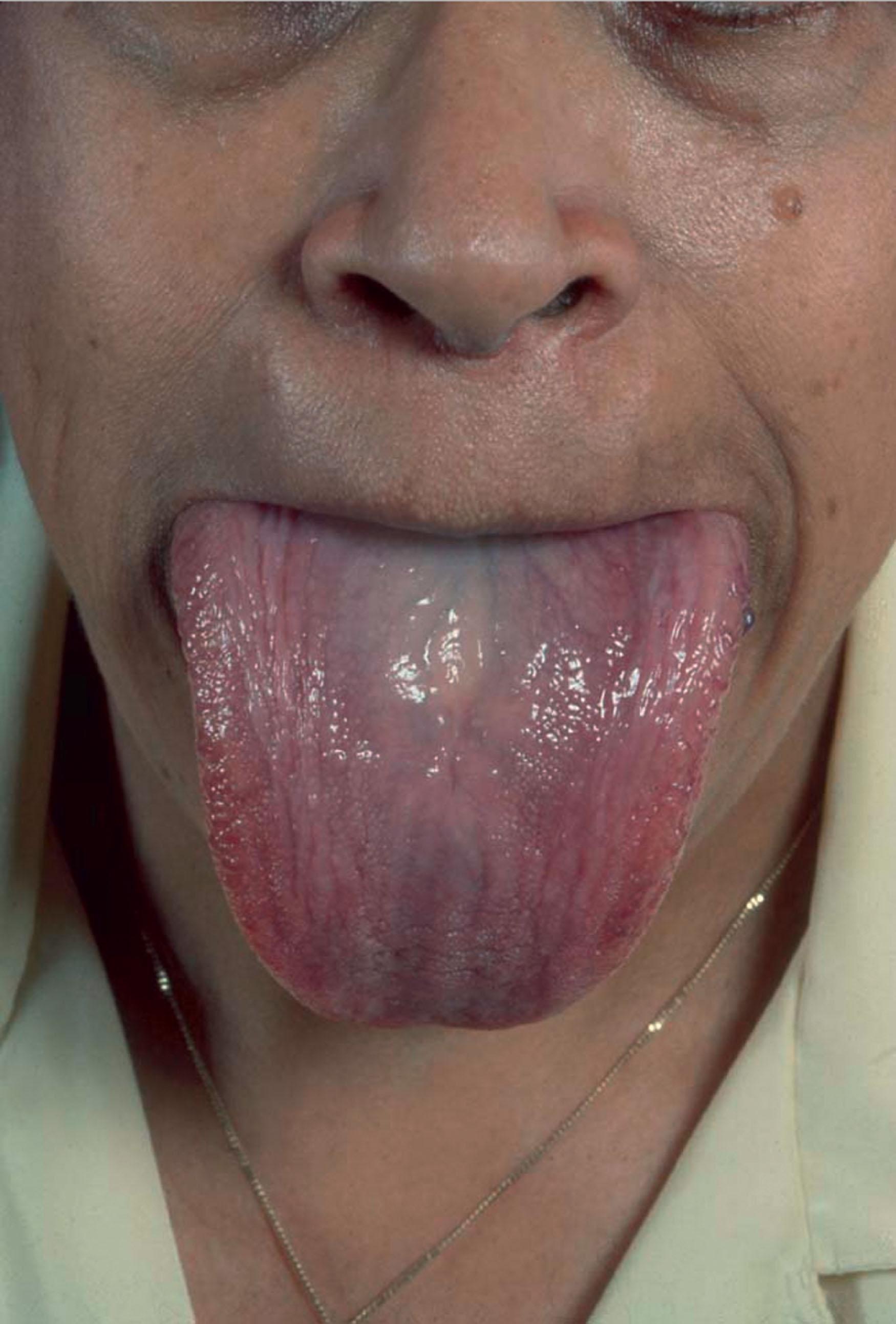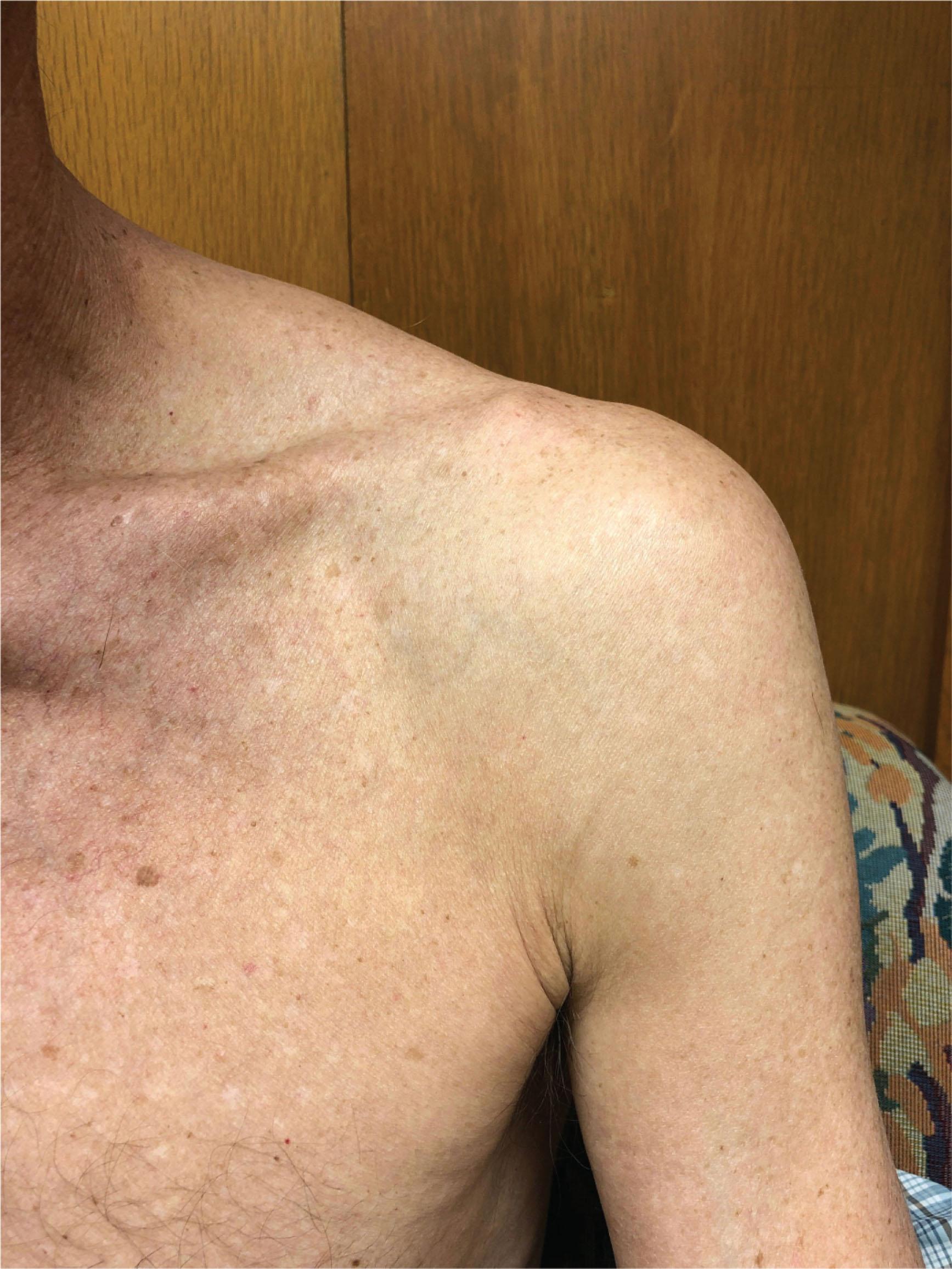Physical Address
304 North Cardinal St.
Dorchester Center, MA 02124
Amyloidosis is defined as the clinical syndrome associated with deposition of amyloid. Amyloid in tissue is defined by its tinctorial properties of a homogeneous, eosinophilic, hyaline material when viewed by hematoxylin and eosin staining. Amyloid stains specifically with Congo red, demonstrating a deep pink amorphous composition. Although Congo red staining is the sine qua non for the diagnosis of amyloid, many pathology laboratories prefer the use of sulfated Alcian blue or crystal violet for screening. A second requirement is that the Congo red-positive histologic finding must demonstrate apple-green birefringence when observed under polarized light. A positive crystal violet or sulfated Alcian blue stain should be confirmed with Congo red staining.
The term amyloid is a misnomer. The term was first used in 1838 by a German botanist because the tissue stained blue with iodine and was incorrectly thought to be starch-like, thus the terminology of amyloid . In Vienna, Rokitansky believed that the material was not starch but rather made of lipid composition and used the term lardaceous degeneration for amyloid. Both were incorrect because all forms of amyloid appear to be protein-derived.
By electron microscopy, amyloid has been shown to be fibrillar in origin with an approximate diameter of 9.5 nm, and linear nonbranching and comprised of protofilaments ( Fig. 93.1 ). The Congo red binding occurs because the protein misfolds from the physiologic configuration of the α-helix into a β-pleated sheet, which is directly responsible for its insolubility and resistance to proteolysis. Amyloid is highly resistant to solubilization unless it is subjected to the harshest denaturation conditions. This insolubility in the physiologic solution likely contributes to the amyloid's ability to disrupt normal organ function and leads to the clinical disease amyloidosis, the clinical syndrome associated with deposition of amyloid.
The incidence of immunoglobulin light-chain amyloidosis is estimated to be approximately 1.2 per 100,000 person years. The rate of the disease is not increasing. One would expect 3852 new cases of amyloid light-chain (AL) amyloidosis in the United States each year. It is the cause of death in 0.58 of 1000 recorded deaths and is responsible for 0.8% of end-stage renal disease. At the Mayo Clinic, AL amyloidosis represents 9% of all patients seen with monoclonal gammopathies. Half of these patients have over 10% plasma cells in the bone marrow fulfilling criteria for smoldering multiple myeloma. At the time of diagnosis of amyloidosis, if multiple myeloma is not present it will only be developed subsequently in 0.4% of patients. At the time of diagnosis of light-chain amyloidosis 8% have been found to have coexisting multiple myeloma. AL amyloidosis represents 52% of all patients seen with amyloidosis. However, hereditary amyloidosis now accounts for 5% of patients, localized amyloidosis 9% of patients, wild-type TTR (TTRwt) (senile systemic amyloidosis) 32% of patients, and secondary amyloidosis 1% of patients. All these forms of amyloidosis have the same tinctorial properties in the histologic section and must be distinguished using other techniques. The reported overall mean age-adjusted mortality rate from amyloidosis as the underlying cause of death has doubled from 1.77 to 3.96 per 100,000 population.
The cause of the plasma cell dyscrasia that underlies AL amyloidosis remains unknown. There does not appear to be a linkage to any specific occupation or toxic chemical exposure. No environmental agents have been linked to the development of amyloidosis. However, the Veterans Administration in the United States considers amyloidosis in a veteran who was exposed to Agent Orange (dioxin) during the Vietnam era to have a service-connected illness.
Amyloidosis may be systemic or localized. The localized forms do not require systemic chemotherapy. The distinction is, therefore, important so that patients for whom chemotherapy will not be of benefit are not inappropriately subjected to this form of therapy. Localized amyloidosis can be suspected, usually based on the location of the deposits, as discussed in the “Clinical Manifestations” section below.
Familial amyloidosis is, for most patients, caused by an inherited mutation of transthyretin (TTR). It is difficult to distinguish from light-chain amyloidosis because the clinical manifestations may be quite similar. Other inherited forms of amyloidosis have been associated with apolipoprotein A1 mutations, fibrinogen A α mutations, and mutations of gelsolin.
Secondary systemic amyloidosis is amyloidosis that is usually a consequence of a sustained inflammatory process. The frequency of symptomatic secondary systemic amyloidosis has been in a sharp decline for the past decade. Previously, secondary systemic amyloidosis was a consequence of an uncontrolled inflammatory process, typically inflammatory polyarthropathies, such as juvenile rheumatoid arthritis, psoriatic arthritis, or ankylosing spondylitis. Another cause was long-standing inflammatory bowel disease. Amyloidosis as a consequence of these inflammatory processes has fallen sharply with the introduction of biologic agents that function as inhibitors of interleukin-1, interleukin-6, and inhibitors of tumor necrosis factor α (TNF-α). Sporadic patients are seen with multiple cutaneous abscesses, usually as a result of subcutaneous injection of contaminated narcotics. Patients can also be seen with chronic infections related to paraplegia or quadriplegia. Rare patients with lifelong bronchiectasis related to cystic fibrosis can develop systemic amyloidosis. There are also forms of inherited secondary amyloidosis associated with familial inflammatory syndromes such as familial Mediterranean fever or mutations of the TNF receptor gene (so-called TNF receptor-associated periodic syndrome).
In immunoglobulin light-chain amyloidosis, the immunoglobulin fragments have specific thermodynamic instability that causes them to misfold into the insoluble amyloid configuration. The injection of immunoglobulin light chains purified from the urine of patients with multiple myeloma will not produce amyloid when injected into mice. However, when the light chains are extracted from the urine of patients with light-chain amyloidosis and injected into mice, it will produce amyloid deposits and organ dysfunction, suggesting that the specifics of the immunoglobulin light chain are important in determining its propensity to misfold into amyloids. Monoclonal immunoglobulin light chains can be converted in vitro to amyloid by in vitro digestion with pepsin. Historically, before it was clearly understood that amyloidosis was derived from a plasma cell dyscrasia with the development of “toxic” immunoglobulin light chains, the term primary amyloidosis was used as a consequence of the lack of understanding of the pathophysiology. This term should be abandoned, and the term immunoglobulin light-chain amyloidosis or AL amyloidosis (amyloid light chain) should be used. Many forms of localized amyloidosis are also derived from immunoglobulin light chains, but there is no evidence of a systemic plasma cell dyscrasia, and anti-plasma cell chemotherapy is contraindicated. Virtually all patients with systemic AL amyloidosis have a demonstrable clonal plasma cell disorder. In monoclonal gammopathy of undetermined significance (MGUS) and multiple myeloma, two-thirds of the immunoglobulin light chains are κ type. In AL amyloidosis, nearly three-fourths of the light chains are of λ origin ( Fig. 93.2 ), suggesting that there is a greater propensity for λ light chains to misfold into amyloid configuration. The λ 6 subgroup of light chains is exclusively associated with amyloid deposition. There are also abnormalities in amyloid-associated germline gene use. A preferential use of variable lambda (VL) germline genes is noted for ALκ and AL λ patients. There is a significant correlation between the use of V λ 6 germline, 6a, and renal involvement as well as the λ 3 gene, 3r, with soft tissue AL. Identification of the clonal VL gene in AL has important implications regarding clinical outcome.

Chromosomal aberrations of the plasma cells in AL amyloidosis have also been recognized. Interphase fluorescence in situ hybridization (FISH) has detected a gain of 1q21, predicting a poor overall survival, and is an independent prognostic factor. Patients with t(11;14) have a longer median overall survival. The t(11;14) is associated with lower response rates to bortezomib-containing regimens. This translocation is seen in 50% of AL patients compared to 15% of myeloma patients. This high prevalence has led to the exploration of venetoclax as a possible therapy for AL amyloidosis. Translocation (11;14) suppresses the emergence of sub-clones and likely accounts for the lower frequency of −17p and 1q+ in AL amyloidosis. Deletion 13q14 and hyperdiploidy are prognostically neutral. Because the incidence of t(11;14) is so high in AL amyloidosis the possibility that venetoclax would be active is rational. Clinical trials are underway to test venetoclax but pending results of these trials it would be reasonable to consider venetoclax in patients who failed the first- or second-line therapies. There are case reports of venetoclax-induced complete response in patients with AL amyloidosis. The combination of daratumumab and venetoclax has been reported to produce both hematological complete response and organ response in a patient with cardiac, renal, peripheral, and autonomic nervous system involvement.
The pathobiology of organ dysfunction associated with amyloidosis has long been assumed to be caused by the direct effect of amyloid protein deposition in tissues. However, there is increasing evidence that the light chains themselves have a toxic effect on tissues as a soluble mediator. A zebrafish model of human light-chain cardiotoxicity has demonstrated that the injection of light chains results in impaired cardiac function, pericardial edema, and increased cell death. Mitogen-activated protein (MAP) kinase activation may mediate this cardiotoxicity, and p38 MAP kinase inhibition reduces cell death and improves cardiac function.
Amyloidosis and multiple myeloma both share the presence in the bone marrow of a clonal population of plasma cells. The number of plasma cells and the immunoglobulin light chains that they produce are both important for prognosis. Patients who have an increased number of plasma cells in the bone marrow with light-chain amyloid-osis have a worse prognosis and shorter overall survival, regardless of whether they manifest any of the clinical criteria associated with multiple myeloma, such as hypercalcemia, renal insufficiency, anemia, or destructive bone lesions. There appears to be no survival difference between patients who have an elevated plasma cell count over 10% in their bone marrow and whether they have overt (CRAB—hyperCalcemia, Renal insufficiency, Anemia, Bone lesions) symptoms of myeloma. The therapeutic import has led our group to recommend induction chemotherapy for patients with AL amyloidosis at a diagnosis prior to consolidative, autologous stem cell transplantation.
Patient 1 is a 46-year-old man who, 10 months prior to diagnosis, began to develop cramping abdominal pain associated with an unexplained 45-lb weight loss. Four months later, he began to develop episodes of orthostatic syncope and was documented to have an orthostatic drop in blood pressure from systolic 110 mmHg in supine to 66 mmHg when standing. As a consequence of his abdominal cramping, the patient underwent endoscopy and colonoscopy. Biopsies were obtained from the duodenum, proximal jejunum, colon, and rectum, all of which demonstrated amyloid deposits. Subsequently, a bone marrow biopsy was performed that showed 4% clonal plasma cells. A subcutaneous fat aspirate was positive for amyloid. The plasma cells showed a CCND1/IgH fusion t(11;14). The patient's hemoglobin level was normal, as were his creatinine, alkaline phosphatase, and urinary protein. The patient had a λ free light chain level of 92.8 mg/L, κ free light chain of 10.9 mg/L, and a ratio of 0.12.
This patient presented with amyloid autonomic neuropathy, leading to gastrointestinal (GI) tract dysmotility and pain as well as orthostatic hypotension. There was clear-cut evidence of a low-volume plasma cell dyscrasia. Orthostatic hypotension causing lightheadedness is a very nonspecific complaint, and syncope owing to amyloid orthostatic hypotension is easily overlooked because of its infrequency.
A 61-year-old man with a known immunoglobulin G λ MGUS of 0.6 mg/dL was monitored on an annual basis with no change in the level of the monoclonal protein over a period of 3 years. He developed progressive fatigue and shortness of breath. He was evaluated by a cardiologist, and his echocardiogram showed thickening that was interpreted to be related to hypertension, with a normal ejection fraction. The patient was placed on lisinopril and did not improve. He returned and underwent catheterization with coronary angiography. His coronary arteries were normal, and he was diagnosed with deconditioning. His dyspnea continued, and he was referred to a pulmonologist, who recognized the long-standing monoclonal gammopathy and obtained light chain studies that showed a λ light chain of 410 mg/L and κ of 10 mg/dL. The patient underwent a subcutaneous fat aspiration that demonstrated amyloid deposits, which, by mass spectroscopy, were found to be of λ origin. At this point, the patient had New York Heart Association class IV heart failure; he died 3 months thereafter.
This case is an example of a classic failure to recognize that patients with monoclonal gammopathies should have AL amyloidosis included in the differential diagnosis. The fact that the monoclonal protein was stable would certainly argue against the development of multiple myeloma, but light-chain amyloidosis regularly occurs without any change in the M component over time. The failure to recognize the patient's progressive fatigue and shortness of breath as cardiac amyloid is not unusual. The echocardiographic findings of thickening were interpreted as being caused by hypertension, but, in fact, they were caused by infiltrative cardiomyopathy, and the cardiac catheterization and angiogram without an endomyocardial biopsy led to a missed diagnosis. Only an increased index of suspicion in patients with a known monoclonal protein allowed this diagnosis to be confirmed.
One of the major difficulties in the diagnosis of amyloidosis is that there is virtually no blood test or imaging study that is diagnostic of the disease. The most common symptoms associated with amyloidosis are fatigue, lower extremity edema (may be cardiac or renal), unexplained weight loss (often leading to search for occult malignancy), exertional dyspnea, orthostatic hypotension, and paresthesias. These symptoms are quite vague, and in a general medical practice, there are hundreds of disorders that are far more common and are responsible for light-chain amyloidosis. As noticed in Patient 2, the fatigue, which is often caused by early cardiac amyloid but is not associated with overt congestive heart failure, can be missed. Cardiac amyloidosis is a classic form of heart failure with a preserved ejection fraction owing to the restrictive physiology associated with amyloidosis. The typical echocardiographic findings include thickening of the interventricular septum due to infiltration with amyloid (usually >12 mm), a decline in global longitudinal strain (normal is greater than −18%) and the slowing of filling of the ventricles during diastole due to non-compliant walls.
Edema in amyloidosis may be a manifestation of high right-sided filling pressures, leading to lower extremity edema, or it may be a consequence of renal involvement with the nephrotic syndrome (peripheral edema, hypoalbuminemia, hyperlipidemia, and proteinuria). Even when nephrotic range proteinuria is seen, amyloidosis, which is known to cause nephrotic syndrome in 10% of adults who are nondiabetic, is infrequently considered in the differential diagnosis, which would include minimal change glomerulopathy, as well as membranous and membranoproliferative glomerulopathy.
The physical findings that are known to be associated with light-chain amyloidosis include enlargement of the tongue (15%) ( Fig. 93.3 ) and periorbital purpura (12%). These findings are highly specific when recognized. However, although they are highly specific, they lack sensitivity because nearly 80% of patients with amyloidosis lack both of these physical features. It is common for an enlarged tongue in amyloid to be misdiagnosed as suspected glossal cancer or a manifestation of acromegaly. Many patients with significant tongue enlargement needlessly undergo a painful and often hemorrhagic tongue biopsy, which could be avoided if the diagnosis was considered. Patients with enlargement of the tongue frequently have major indentations on the underside of their tongue from their teeth and the continuous pressure that the tongue exerts against their lower jaw. The purpura is also quite specific, and the patient often will note the development of purpura simply by rubbing of the eyelids. However, these patients often undergo an evaluation for a coagulation disorder or are simply reassured that purpura is benign, and the physical findings do not trigger an investigation for light-chain amyloidosis ( Fig. 93.4 ).


Hepatomegaly is seen in approximately 10% of patients with amyloidosis, but it is nonspecific, and an imaging of the liver will show homogeneous enlargement without filling defects. Occasionally, patients will have a widespread vascular amyloid that will result in claudication of the calf, buttock, upper extremities, and jaw. Occasionally, these patients will undergo temporal artery biopsy, which, when appropriately stained, will show amyloid. More often, these patients will be given an empiric diagnosis of polymyalgia rheumatica and be placed on corticosteroids without appropriate screening. The rarest physical finding in amyloidosis is periarticular infiltration of the synovium in the upper extremities, leading to the “shoulder pad” sign ( Fig. 93.5 ). This causes a continuous, chronic, low-grade pain caused by the periarticular infiltration. Diagnosis in this setting requires arthrocentesis and the demonstration of Congo red-positive deposits in the synovial fluid.

Become a Clinical Tree membership for Full access and enjoy Unlimited articles
If you are a member. Log in here